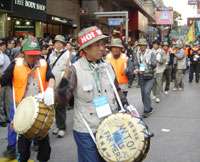HONG KONG — Asia's poorest countries are being out-muscled economically by China and remain stranded in poverty despite a regional boom in free trade, the United Nations says.
In a 152-page report released last week, the U.N. Development Program (UNDP) disputes the U.S. position that busting down trade barriers is the surest way to reduce poverty. Instead, the U.N. agency advises poor Asian countries to do what Japan and South Korea did successfully in the 1970s and '80s: protect key industries temporarily with tariffs before exposing them to foreign competition.
Free-trade advocates "assume that freer and freer trade will create greater and greater wealth," says Walden Bello, executive director of the anti-poverty group Focus on the Global South in Bangkok. "But experience has shown this is not the case."
The UNDP says Asia's poorest countries have been left behind even as trade has exploded across the region. From 1980 to 2000, tariffs fell from an average 34% to 8% in East Asia and the Pacific and from 60% to 18% in South Asia. As tariffs came down, trade boomed — rising from 45% of Asia-Pacific economic activity in 1990 to 81% by 2003. The region now accounts for about 30% of world exports, a figure the UNDP believes could hit 50% within a decade.
But across Asia, job growth fell from 337 million in the '80s to 176 million in the '90s, not fast enough to keep up with rising populations. Increasingly, the UNDP says, expanding trade is creating jobs for skilled laborers, not for uneducated rural Asians who can no longer make a living on the farm.
One problem: Inexperienced trade negotiators from poor countries are frequently outmaneuvered and enter into trade pacts on unfavorable terms. Before it joined the World Trade Organization in 2004, for instance, impoverished Cambodia agreed to expose its farmers to more competition than the wealthy European Union and the United States were willing to accept for theirs — even though more than 80% of Cambodians live on farms, according to the anti-poverty group Oxfam International.
The Cambodian government, human-rights activist Thun Saray says, "only wanted access to the WTO. They didn't care about the conditions."
Moreover, China's rising economic clout is doing little to benefit the poorest Asian countries, UNDP says. Reason: Their low-tech economies don't produce the sophisticated machinery and products that China needs. More than three-quarters of China's Asian trade is with the region's wealthiest countries such as Japan, Singapore and South Korea. And China's trade with the poorest Asian countries is unbalanced: In 2004, it ran trade surpluses of $1.8 billion with Bangladesh, $422 million with Cambodia and $731 million with Myanmar.
Pham called on China to offer favorable trade terms to the poorest Asian countries, something it has done with African countries. The UNDP also urged poor countries to impose tariffs on farm imports to protect their own farmers and food supplies.
Economist Fahmida Khatun, senior research fellow at the Centre for Policy Dialogue in Dhaka, Bangladesh, agrees that free trade creates losers as well as winners. But in her country, she says, many of the problems are homegrown: rampant corruption, government bureaucracy and crumbling infrastructure, especially at Bangladesh's ports.
She also notes that Bangladesh's huge trade deficit with China isn't necessarily evidence of a lopsided relationship. Instead, Bangladesh needs Chinese machinery and textiles to feed its own thriving garment industry. She says that she and her colleagues have been surveying dozens of local garment factories and have found that managers are confident their low-wage workforce will keep them competitive in global markets.
"They're not afraid of China at all, actually," she says.







